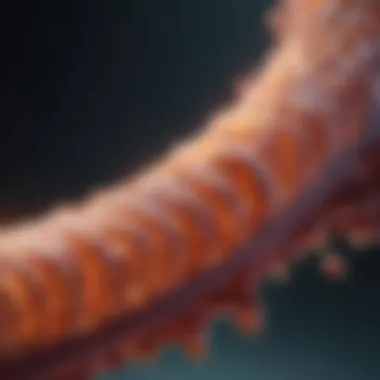CML Pathology: Comprehensive Insights and Understanding


Intro
Chronic Myeloid Leukemia (CML) is a type of cancer that affects the blood and bone marrow. It is crucial to explore the depth of its pathology and understand the underlying factors contributing to its development. This section aims to establish a foundation, guiding readers through the intricate aspects of CML, making it accessible to students, researchers, educators, and professionals.
Research Overview
Chronic Myeloid Leukemia is characterized by the overproduction of myeloid cells in the bone marrow, caused primarily by genetic mutations. A significant finding in CML pathology is the presence of the Philadelphia chromosome, resulting from a translocation between chromosome 9 and 22. This chromosomal abnormality leads to the creation of the BCR-ABL fusion gene, which plays a pivotal role in the disease's pathogenesis.
Key findings suggest that environmental factors may not solely be responsible for CML development. Instead, a combination of genetic predispositions and external influences triggers this complex disease. This understanding emphasizes the importance of a multi-faceted approach to CML research.
"CML exemplifies the interplay between genetics and environment, underscoring the need for interdisciplinary research in understanding cancer."
Summary of Key Findings
- The Philadelphia chromosome is a hallmark of CML.
- BCR-ABL fusion leads to unregulated cell division.
- Genetic and environmental factors interact in its pathology.
Importance of the Research
Research into CML is vital for several reasons:
- Provides insight into cancer biology.
- Aids in developing targeted therapies.
- Enhances understanding of genetic disorders.
Methodology
An effective study of CML requires a robust approach to research design and data collection.
Study Design
The studies on CML typically adopt a longitudinal design. This allows researchers to observe the progression of the disease over time, collecting insights into the effectiveness of various treatment regimens.
Data Collection Techniques
Researchers utilize a combination of techniques:
- Retrospective data analysis of patient records.
- Prospective clinical trials assessing new therapeutic approaches.
- Genetic sequencing to identify specific mutations associated with the disease.
Preamble to Chronic Myeloid Leukemia
Chronic Myeloid Leukemia, commonly referred to as CML, is a significant condition that deserves careful consideration in the field of hematology. The pathology behind CML involves intricate mechanisms that relate to specific genetic mutations and environmental influences. Understanding these elements is crucial for researchers and clinicians alike, as it directly impacts both diagnosis and treatment strategies.
This section lays a foundational perspective on CML, helping readers grasp its complexities and clinical implications. The elucidation of CML's definition, along with its historical evolution, provides context that enhances our comprehension of current treatment paradigms and future research directions.
Defining
Chronic Myeloid Leukemia is a type of cancer that affects the blood and bone marrow. It is characterized by the excessive growth of myeloid cells, a type of white blood cell. The hallmark of CML is the presence of the Philadelphia chromosome, which results from a translocation between chromosomes 9 and 22. This genetic anomaly leads to the formation of the BCR-ABL fusion gene, responsible for overproduction of these cells. Patients typically present with a marked elevation of white blood cells on their blood tests, but may be asymptomatic in the early stages.
Historical Context
The understanding of Chronic Myeloid Leukemia has evolved significantly since its early descriptions in the medical literature. The first coherent accounts date back to the early 19th century, although CML was often confused with other blood disorders. By the 1960s, the connection between CML and the Philadelphia chromosome was established, revolutionizing diagnosis and management.
Over the years, research has led to breakthroughs in treatment options, most notably with the introduction of Imatinib in the early 2000s. This milestone therapy has transformed the prognosis for many CML patients, emphasizing how historical advancements in understanding the disease have practical implications for clinical practice today.
Pathophysiology of
Understanding the pathophysiology of Chronic Myeloid Leukemia (CML) is critical as it unveils the underlying biological mechanisms driving the disease. This section explores the genetic mutations, cellular interactions, and molecular dynamics that characterize CML. Each component plays a significant role in the progression and manifestation of the disease. Insights gained from the pathophysiological study of CML can inform treatment strategies and prognostic assessments.
Genetic Mutations and Chromosomal Translocations


BCR-ABL Fusion Gene
The BCR-ABL fusion gene is a hallmark of CML. It results from a specific chromosomal translocation between chromosomes 9 and 22, leading to the Philadelphia chromosome. This abnormal gene encodes a hybrid protein with constitutive tyrosine kinase activity. This characteristic is vital as it promotes uncontrolled cell division and survival of myeloid cells. Understanding the role of this fusion gene allows researchers and clinicians to focus on targeted therapies, which can significantly improve patient outcomes. Its presence serves as a reliable diagnostic marker for CML.
Role of Tyrosine Kinase
Tyrosine kinases are enzymes that catalyze the transfer of phosphate groups to specific amino acids in proteins. In CML, the BCR-ABL fusion gene leads to overactivity of the tyrosine kinase pathway. The dysregulated signaling contributes to leukemogenesis. Targeting these pathways with inhibitors has revolutionized treatment, proving the importance of understanding their role. Tyrosine kinase inhibitors, such as Imatinib, have shown substantial effectiveness in managing CML, providing a clear benefit to patients.
Cellular and Molecular Mechanisms
Clonal Evolution and Stem Cell Dynamics
Clonal evolution describes the process by which certain cells within a tumor acquire genetic mutations that confer a growth advantage. In CML, this dynamic can lead to treatment resistance and disease progression. The clonal selection model explains how certain subclones flourish under selective pressure from therapies. Recognizing these patterns assists in tailoring treatment approaches for individual patients.
Stem cell dynamics also play a crucial role in CML. The interaction between malignant stem cells and their niche affects disease behavior and treatment responses. Understanding these processes can inform the development of novel therapeutic strategies.
Microenvironment Influences
The microenvironment surrounding the leukemic cells significantly impacts their behavior. Supportive interactions with bone marrow stromal cells, cytokines, and extracellular matrix components can enhance malignant cell survival and proliferation. A thorough understanding of these influences can lead to innovative approaches targeting the supportive stroma, potentially improving therapy efficacy. The interplay between CML cells and their microenvironment emphasizes the complexity of therapeutic efforts and the need for multifaceted treatment plans.
"The pathophysiological characteristics of CML underscore the necessity for ongoing research and clinical innovation."
In summary, the pathophysiology of CML involves intricate genetic alterations and cellular interactions that contribute to disease development and progression. Insights into these mechanisms are essential for advancing treatment methods and improving patient prognoses.
Clinical Presentation
The clinical presentation of Chronic Myeloid Leukemia (CML) is a crucial component in understanding this disease. The symptoms and signs that manifest can often provide initial indications of the underlying pathology. Recognizing these clinical features can aid in early diagnosis and prompt treatment, ultimately improving patient outcomes.
Symptoms and Signs
Fatigue and Weight Loss
Fatigue and weight loss are prominent symptoms in patients with CML. These manifestations occur due to the body's inability to effectively manage the abnormal proliferation of leukemic cells. Fatigue is often characterized by an overwhelming sense of tiredness or exhaustion that is not relieved by rest. Weight loss may result from a combination of increased metabolic demands and a lack of appetite, which can stem from various factors including stress and physical discomfort.
Understanding the significance of fatigue and weight loss is essential for identifying those at risk for advanced disease stages; these symptoms often correlate with disease progression. A key characteristic of these symptoms is their persistent nature, which can disrupt daily life activities. They serve not just as fatigue indicators but also as potential alerts for health professionals to explore CML further.
Splenomegaly
Splenomegaly, or enlargement of the spleen, is another critical sign in CML. It can frequently be detected during a physical examination. The spleen's enlargement arises from the accumulation of leukemic cells, leading to its increased workload. Clinically, splenomegaly may present as discomfort or pain in the left upper abdomen. This symptom is noteworthy because it indicates active disease and can be associated with other complications such as hypersplenism, where the spleen overly destroys blood cells.
Both fatigue and splenomegaly contribute to the overall understanding of CML. They highlight the urgent need to monitor patients closely and reinforce the importance of regular check-ups and blood tests.
Subtypes of
Understanding the subtypes of CML is important for tailoring treatment strategies. The classification of CML not only influences patient management but also is pivotal in prognostic discussions and family consultations.
Chronic Phase
The chronic phase is the initial phase of CML and is often asymptomatic, which can make early detection challenging. During this phase, the cancerous cells are typically stable and less aggressive. Most patients respond favorably to tyrosine kinase inhibitors during this period, which are the standard treatment option. The chronic phase is characterized by a relatively normal life expectancy compared to advanced phases. This makes it a critical focus for intervention.
Accelerated Phase
The accelerated phase follows the chronic phase and is marked by a change in disease behavior; symptoms may become more apparent. Patients often present with elevated white blood cell counts, and splenomegaly may worsen. This phase indicates a transition towards an aggressive disease state. Recognizing the accelerated phase is crucial as it often requires immediate changes in management strategies, including the potential need for more intensive therapies or clinical trials.
Blast Crisis
Blast crisis is the most advanced stage in CML, resembling acute leukemia with a sudden surge in immature cells. This phase indicates treatment failure and is associated with severe symptoms, including severe fatigue, bleeding, and bone pain. The management options become limited due to the aggressive nature of the disease at this stage. Recognizing blast crisis early is essential, as it significantly affects prognosis and treatment outcomes.
Diagnostic Approaches


Diagnostic approaches for Chronic Myeloid Leukemia (CML) are crucial in establishing the disease's presence and guiding treatment strategies. Accurate diagnosis helps to determine the disease's phase and severity, which ultimately affects management decisions.
Laboratory Tests
Complete Blood Count
A Complete Blood Count (CBC) serves as a fundamental tool in diagnosing CML. This test measures various components of the blood, including red blood cells, white blood cells, and platelets. One key characteristic of the CBC is its ability to reveal leukocytosis, which is an elevated white blood cell count, commonly seen in CML patients.
The CBC is beneficial due to its accessibility and simplicity. Most healthcare facilities can perform a CBC, making it a routine part of an initial evaluation. Its unique feature lies in the detail it provides regarding blood cell morphology and function. However, while the CBC is informative, it does not distinguish CML from other types of leukemia, which is a limitation that must be acknowledged.
BCR-ABL Testing
BCR-ABL testing is a pivotal diagnostic tool for confirming CML. This test specifically identifies the presence of the BCR-ABL fusion gene, which results from the Philadelphia chromosome abnormality. The key characteristic that sets BCR-ABL testing apart is its high specificity for CML, making it the definitive test for diagnosis.
The test is a powerful choice in this article as it provides clear insights into the genetic alterations driving the disease. Its unique feature is the ability to guide targeted therapies, as the presence of BCR-ABL can influence the treatment plan significantly. Nonetheless, BCR-ABL testing comes with challenges, such as the need for specialized laboratory equipment and expertise, which may not be available everywhere, potentially limiting access.
Imaging Techniques
Ultrasound Studies
Ultrasound studies can play a supplementary role in diagnosing CML, especially in assessing splenomegaly and hepatomegaly. These imaging techniques allow for non-invasive visualization of organ enlargement, which commonly occurs in CML. A significant aspect of ultrasound is its real-time imaging capability, making it possible to observe blood flow and other dynamic changes.
Ultrasound is a beneficial option as it does not expose patients to radiation and is widely available. Its unique feature is that it can be used repeatedly without risk of additional health concerns. However, limitations include operator dependency and the potential for variable accuracy in larger patients, which can affect the quality of results.
CT Scans
CT scans provide detailed cross-sectional images of the body, which can be particularly useful in evaluating complications of CML. This imaging technique can help identify lymphadenopathy and organ involvement, aiding in assessing disease progression. A notable characteristic of CT scans is their ability to generate high-resolution images that can reveal subtle abnormalities.
CT scans are advantageous for their detailed anatomical insights and versatility in evaluating different aspects of CML. Nonetheless, there are drawbacks, such as exposure to ionizing radiation and higher costs compared to other imaging modalities. Moreover, CT scans may also require the use of contrast agents, which can pose risks for certain patients.
Treatment Modalities
The treatment modalities for Chronic Myeloid Leukemia (CML) are pivotal in managing the disease and improving patient outcomes. These modalities range from targeted therapies to more traditional methods, each offering unique benefits and considerations. Understanding these treatment options is critical as they directly influence the patient's quality of life and long-term prognosis.
Tyrosine Kinase Inhibitors
Tyrosine kinase inhibitors (TKIs) represent the first line of treatment for CML. These drugs specifically target the BCR-ABL fusion protein, which drives the proliferation of CML cells. Their emergence has revolutionized how this leukemia is treated, enabling many patients to achieve long-lasting remissions.
Imatinib
Imatinib is a landmark drug in CML treatment. It blocks the activity of the BCR-ABL fusion protein, effectively halting the growth of cancerous cells. A key characteristic of Imatinib is its oral administration, which ensures patient compliance and convenience. Its benefits include a high rate of response and a significant decrease in disease progression. However, some patients might experience side effects such as nausea and edema, which can impact their quality of life.
Dasatinib
Dasatinib is another potent TKI used in CML therapy, especially for patients who show resistance or intolerance to Imatinib. A notable aspect of Dasatinib is its ability to inhibit multiple pathways involved in cancer progression, offering a broader range of action. It is also taken orally, making it accessible for patients. The unique feature of Dasatinib is its rapid achievement of hematologic and cytogenetic responses, which can be crucial in managing advanced phases of CML. Yet, it can present side effects like pleural effusion and pulmonary hypertension, raising considerations for certain patient populations.
Nilotinib
Nilotinib is another significant TKI in the treatment landscape for CML. It offers a more selective inhibition of the BCR-ABL fusion protein, which enhances its efficacy. Patients often prefer Nilotinib due to its favorable response rates and longer durability of effect. One unique attribute of Nilotinib is its ability to target resistance mutations, making it a valuable option for those whose disease has progressed on previous therapies. However, it may lead to metabolic changes, including hyperglycemia and cardiac issues, requiring careful monitoring.
Stem Cell Transplantation
Stem cell transplantation remains a vital treatment option for certain patients with CML. While TKIs often manage early stages effectively, transplantation could be necessary for more advanced disease.
Indications
The indications for stem cell transplantation hinge on several factors, including the phase of CML, treatment response, and patient health. Patients with a poor response to TKIs or those experiencing a blast crisis may require transplantation. The key characteristic of this therapy is its potential for a curative outcome, unlike other treatments. However, it involves significant risks, including graft-versus-host disease and complications from the conditioning regimen, making careful patient selection essential.
Long-Term Outcomes


Long-term outcomes of stem cell transplantation in CML patients vary widely. Many patients achieve durable remission and are free from disease after successful transplantation. This unique feature underscores the importance of this modality as a potential cure for selected cases. Conversely, long-term follow-ups reveal risks such as secondary malignancies and organ dysfunction, necessitating close monitoring and supportive care.
Advances in treatment modalities for CML have reshaped the management of the disease, enhancing survival rates and quality of life for many patients.
The treatment modalities for CML illustrate the ongoing progress in hematology and oncology. As science evolves, new therapeutic strategies will likely emerge to further refine these approaches.
Recent Advances in Research
The study of Chronic Myeloid Leukemia (CML) has progressed significantly in recent years. Researchers have worked to shape our understanding of this malignancy, revealing new aspects of its pathology and treatment. Innovations in therapeutic approaches and biomarker identification have opened avenues for better patient care and outcomes. Such advances are vital as they directly impact the future directions in managing CML.
Emerging Therapeutics
Novel Agents in Clinical Trials
Novel agents in clinical trials are changing the landscape of CML treatment. They provide hope for patients, especially those who do not respond well to standard therapies. Current trials investigate several medications that target various aspects of the disease.
A key characteristic of these novel agents is their ability to overcome resistance often seen with established treatments like Imatinib. This resistance can stem from genetic mutations in the BCR-ABL fusion gene, making it crucial to explore alternatives.
These agents provide unique benefits by addressing unmet needs in patient populations, particularly those experiencing disease progression. However, challenges remain, such as the need for extensive testing to determine their safety and effectiveness. The potential for improved response rates can make these therapeutics a strong choice in the overall management of CML.
Targeting Resistance Mechanisms
Targeting resistance mechanisms is a critical part of advancing CML treatments. Understanding how patients develop resistance to existing therapies has led to strategies designed to counteract these effects.
Therapies that target the pathways and molecular changes contributing to resistance are gaining traction. A significant feature of these approaches is their capacity to personalize treatment plans, ensuring that therapies align with individual disease profiles.
This individualized approach can enhance treatment effectiveness. However, the complexity of resistance mechanisms may complicate establishing universal treatment guidelines, creating a need for ongoing research in this area.
Biomarkers and Prognostic Factors
Biomarkers and prognostic factors are pivotal in predicting outcomes for CML patients. Research in this field focuses on identifying specific markers that can guide treatment decisions and assess patient risk.
Genomic Profiling
Genomic profiling has emerged as a powerful tool in CML. By analyzing genetic variations within a tumor, clinicians can identify patients who may respond better to specific therapies. This characteristic allows for more tailored treatment regimens, potentially increasing success rates.
However, genomic profiling can also present challenges, particularly concerning cost and accessibility. The complexity of interpreting genomic data can affect its integration into routine clinical practice, necessitating further advancements in this area.
Response Monitoring Strategies
Response monitoring strategies are essential for managing CML effectively. These strategies involve tracking how well a patient responds to treatment over time. A key characteristic of these monitoring methods is their ability to provide timely feedback, allowing for adjustments in therapy as needed.
The unique feature of these strategies lies in their real-time assessment capabilities. This continuous monitoring helps in identifying suboptimal responses early, which can be critical in improving patient outcomes. However, reliance on regular monitoring can place a burden on healthcare systems and patients alike, calling for a balance between vigilance and practicality.
In summary, innovations in CML research highlight the dynamic changes occurring in understanding and treating this disease. These advances pave the way for improved patient outcomes, emphasizing the need for robust research efforts.
Epilogue
The conclusion serves as a vital component in understanding Chronic Myeloid Leukemia (CML) due to its role in synthesizing the information presented throughout the article. It encapsulates critical insights on the pathology, clinical manifestation, diagnostic strategies, and evolving treatment options for CML. In doing so, it not only reinforces the relevance of anatomical and genetic factors in CML but also highlights the progress made in research and therapeutic approaches.
By acknowledging the intricacies of CML, readers can better appreciate the broader implications for patient care and management strategies. The conclusion enables students, researchers, and professionals to retain a clear framework for recognizing essential elements regarding diagnosis and treatment. Furthermore, it offers an opportunity to reflect on the important application of emerging research on therapeutic advancements, thereby fostering a deeper comprehension of the condition.
In summation, this section encourages continuous engagement with CML research and highlights the importance of understanding pathophysiological mechanisms to improve clinical outcomes.
Summary of Key Points
- Chronic Myeloid Leukemia (CML) stems from genetic mutations, most notably the BCR-ABL fusion gene, influencing cellular dynamics.
- Clinical presentations include symptoms like fatigue and splenomegaly, with significant phases: chronic, accelerated, and blast crisis.
- Diagnostic approaches leverage laboratory tests, such as complete blood counts, along with imaging techniques like CT scans.
- Treatment modalities focus on tyrosine kinase inhibitors and stem cell transplantation, showcasing advancements in therapeutic strategies.
- Recent research highlights emerging therapeutics and potential biomarkers for monitoring, pointing towards a future where targeted treatment becomes more refined.
Future Directions in Research
Future research in CML is poised to explore several promising avenues aimed at enhancing patient outcomes and developing more effective treatments. The following represent potential directions for exploration:
- Targeting Resistance Mechanisms: As resistance to existing therapies like Imatinib becomes a growing concern, understanding the underlying biological factors contributing to this resistance is paramount.
- Genomic Profiling: Delving deeper into genomic characterization will enable personalized medicine approaches, tailoring treatments to individual patient profiles based on genetic makeup.
- Clinical Trials for Novel Agents: Continuous clinical trials assessing new drug combinations and innovative agents may yield breakthroughs in overcoming current treatment limitations, particularly for advanced phases of CML.
- Role of Microenvironment: Further research into the tumor microenvironment's influence on disease progression and treatment resistance could unveil new therapeutic targets.
- Longitudinal Studies: Longitudinal assessments to monitor long-term treatment effects and side effects could improve quality of life for patients undergoing CML therapy.
As we continue to advance in the field, a commitment to rigorous research and collaboration across disciplines will be essential in shaping the future landscape of CML treatment.



